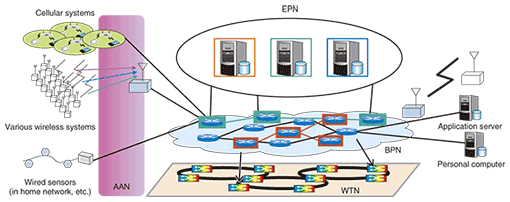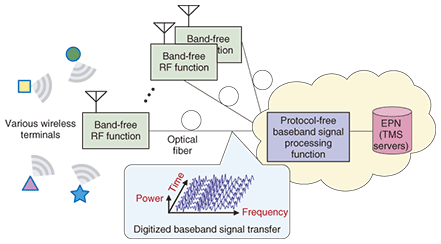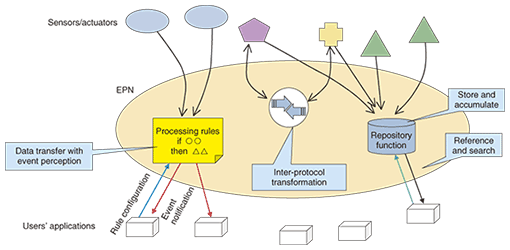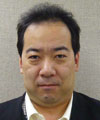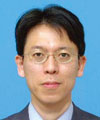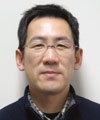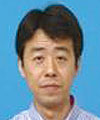 |
|||||||||||||||||||||||||||
|
|
|||||||||||||||||||||||||||
|
Special Feature: Design Concepts for New Generation Carrier Networks Vol. 7, No. 5, pp. 49–55, May 2009. https://doi.org/10.53829/ntr200905sf5 Technologies Towards Networked Objects and Events in the Real WorldAbstractIn this article, we describe our view of a tiny-bandwidth mass service (TMS) over future networks. It will accommodate an enormous number of small terminals having very limited functions, such as sensor nodes and RFID (radio-frequency identification) tags, and provide the infrastructure for inter-object communication, real-world event processing, and context-aware networking. We discuss the requirements, technical challenges, and research topics involved in achieving TMS.
1. IntroductionIt is important to obtain knowledge from the real world, such as the behaviors of people, movement histories of objects, and changes in the environment because such knowledge could lead to improvements in the quality of our lives and a safer, more secure society. NTT Laboratories has been conducting several research projects aimed at establishing infrastructure technologies to transport, store, and process information obtained from the real world. We have given the name tiny-bandwidth mass service (TMS) to a service designed to handle a huge number (mass) of objects each generating small (tiny) amounts of information. In this article, we describe our approach to and some research work on making TMS. 2. Object networking and TMSSince the 1990s, ubiquitous networking has been widely discussed and some applications have been achieved in various ways. Personal communication has already become ubiquitous: mobile phones enable telecommunication everywhere, not only person-to-person communication by voice and video, but also data communication. Active research and development activities are continuing toward wider bandwidth, larger area coverage, and attractive application services. In the field of networking non-human objects, networks of security sensors and cameras, RFID (radio-frequency identification) tags, and IC (integrated circuit) cards have become popular. Telemetry using mobile phone networks has also been implemented. Research and development in this area is also active. One of the efforts of NTT Laboratories here is a wide area ubiquitous network system (WAUN) [1], [2]. WAUN is a cellular network designed to accommodate a large number of wireless terminals that each sends and receives relatively a small amount of information. Its application services include town security, telemetry and remote control, and environmental monitoring. WAUN is intended to be an application-independent platform for networks of objects: terminals for various applications use the same radio modulation and network protocol, and data from these terminals is handled by a common data service mechanism that is also provided by WAUN. WAUN is now at the stage of field experiments [3]. In the future, the wider application of ubiquitous networking will require smaller, simpler, less-expensive terminals. This means that the terminals will have lower performance and limited functionality. Furthermore, the diversity of applications will increase. Therefore, networks should allow non-standard protocols specifically designed for the requirements of an application and the limitations of a terminal. TMS is intended to provide this kind of application-oriented networking among objects. We believe that it will be one of the fundamental components of future networks. Its characteristics can be summarized as follows. TMS is a network service for transferring, storing, and processing information from terminals embedded in real-world objects. Its main functions are to:
While the success of the current Internet can be considered to stem from several reasons, a significant one is the World Wide Web: web technology acts as a common platform for sharing and mashing up information from service providers and users. Search engines allow us to easily obtain information when we want it from a countless number of web pages. Another factor is the wide deployment of access network technologies such as ADSL (asymmetric digital subscriber line), CATV (cable television), FTTH (fiber to the home), and wireless. Our concept for TMS is to build an infrastructure and ecosystem for networking objects similar to today’s Internet for personal computers and mobile phones. For this purpose, various enabling technologies must be established to connect a huge number of terminals (sensors and actuators), gather their data, and select and mash up this information and make it readily available. 3. Components of TMSIn the conceptual design of our future networks (Fig. 1), the main two components of TMS are the adaptive access network (AAN) and the event processing network (EPN).
First, TMS will mean that a huge number of terminals of many different types are connected to the network. Cellular wireless systems such as WAUN are good in terms of area coverage and economical accommodation of a large number of terminals in a uniform manner. In cellular systems, every terminal uses some standard access protocols, and terminals have to perform a relatively rich set of functions such as logical link control and media access control. However, TMS terminal design will usually be severely limited in terms of cost, size, and power supply. Imposing uniform requirements for terminal functionalities in cellular systems might be too great a demand for such small terminals. We think that TMS should accommodate tiny terminals with limited functions by allowing custom protocols designed in a minimalistic way for each specific application service and that it should allow multiple different minimalistic protocols to be used simultaneously and efficiently. We discuss several new wireless access technologies in sections 4 and 8. Another issue is how to handle wired terminals in an application-specific manner in TMS; this is still under consideration. Small terminals can also be limited in other ways. Complex data processing may be impossible. Some terminals may work intermittently and sleep most of the time. The EPN will provide active support for these kinds of terminals. It consists of TMS servers that provide higher-layer functions for data transfer (such as retransmission, duplication, and delay-tolerant hop-by-hop transfer), storage, data searching, etc. Our plan is to construct the EPN as a logical overlay network among TMS servers connected by a broadband packet network (BPN) or wide-area transport network (WTN) [4], as shown in Fig. 1. 4. Flexible wireless access technologiesTo make TMS, we need to provide wireless access networks that can handle a huge number of wireless terminals of various types. Existing base stations and access points can support only the functions of a single wireless system. As a solution, we propose an architecture for a flexible wireless platform [5] that can handle multiple wireless systems simultaneously and efficiently (Fig. 2). The flexible wireless platform consists of a band-free radio-frequency (RF) function module, a protocol-free baseband signal processing function module, and an optical fiber connection between them.
The band-free RF module simultaneously transmits and receives wideband radio waves including the signals of multiple different wireless systems. After a received wideband radio wave has been converted to the baseband and digitized, the baseband signals are transferred to a protocol-free baseband signal processing module via the optical fiber network. The band-free RF module requires both a wide frequency bandwidth and a large dynamic range to increase linearity and reduce noise at the same time. To achieve this, we studied RF devices such as wideband low-noise amplifiers and mixers and RF circuit techniques such as amplitude and phase compensation, variable filtering, multichannel automatic gain control, and ultrawideband voltage controlled oscillators. In addition, we studied techniques for bidirectional transmission so that the signals of different wireless systems can be transmitted and received simultaneously. The protocol-free baseband signal processing module provides collective signal processing functions such as the modulation and demodulation of various wireless systems’ protocols. To separate the desired signal from this bundle of baseband signals, we studied signal processing techniques that offer supersensitivity and high precision, such as efficient estimation of the wireless system’s signal and inference/noise suppression. Multiple band-free RF modules are connected to one protocol-free baseband signal processing module, which performs complex signal processing efficiently. Spatial signal processing can be used: site diversity gain can be achieved by combining signals from multiple antennas, and terminal location can be estimated from the angle and time of arrival of the radio signal at multiple antennas. The introduction of a new wireless protocol can be supported by simply making changes in the protocol-free baseband signal processing modules: the band-free RF modules do not need to be altered. Since TMS handles a huge number of wireless terminals simultaneously, the system throughput might decrease because of more frequent collisions of transmitted signals. To solve this problem, we studied a multiuser detection technique [6] based on spatial signal processing. Most wireless terminals for TMS cannot have multiple antennas because they must operate with low power consumption. Instead of multiple antennas on the terminal, we studied multi-user MIMO (multiple-input, multiple output) technology, in which multiple single-antenna terminals can be coordinated to achieve MIMO-equivalent transmission. 5. Event processing networkThe EPN in future networks is a kind of gigantic database that handles information from a huge number of TMS terminals. We expect the EPN to provide the following functions (Fig. 3).
(1) Data transfer with event perception: The EPN receives data from TMS terminals such as sensors and forwards it to users and programs that want it. Some types of sensors such as trespass detectors and seismometers may generate the same value for nothing happening most of time; then, when something does happen, they emit significant data. The EPN observes the raw data, recognizes the meaningful changes, and forwards only those events to the designated destinations. The EPN will choose the style of data transfer that is appropriate for the application and the event’s properties: transfer options include reliable or best-effort transfer, the number of destinations, and urgent/priority handling. For example, weather data can usually be stored in the EPN repository and not forwarded anywhere instantly; however, when heavy rain falls and the sensor value changes significantly, the EPN will report this event immediately to organizations or systems concerned. The data handling conditions and styles constitute the EPN’s processing rules that are stored in TMS servers. (2) Inter-protocol transformation: The EPN allows multiple application-specific protocols. It is very important that the EPN works as a middleman in communication among different types of terminals to enable mash-up applications. Essential functions are identifier (ID) conversion and protocol conversion. Suppose two terminals, a and b, use protocols A and B, respectively. To enable communication between them, the EPN acts as virtual terminals a’ and b’: it acts as b’ to communicate with a using protocol A and acts as a’ to communicates with b using protocol B. It also performs the necessary conversion between a’ and b’. In the EPN, each TMS terminal is identified by a globally unique ID that is, essentially, a pair consisting of its protocol-specific terminal ID and protocol identifier (protocol name). Moreover, we are considering using some context information for the purpose of addressing, such as terminal location, communication time, and terminal type, or even data itself. (3) Repository functions to support data combination and mash up: As a platform for TMS-based application services, the EPN provides functions such as ones for storing, searching, and performing name resolution on information about objects entities. One of our first attempts to frame the basic functionality is uTupleSpace, which is discussed in section 6. Moreover, in TMS, personal information protection is very important. As a first step, we are investigating appropriate notions for the ownership of data and information, fair use of them, and possible enforcing mechanisms. Other important issues in designing the EPN and TMS servers, which are not discussed here, are scalability, dynamic reorganization capability, and robustness. 6. Model of communication among small terminalsWe are expecting TMS to usher in new classes of application services that use various sensors and actuators. To facilitate the development of such applications, we have designed a communication model for small terminals, called uTupleSpace [7], [8] and are developing a software library based on the model. Our uTupleSpace is based on TupleSpace, a concept used in distributed computing. The “u” indicates ubiquitous. Like TupleSpace, uTupleSpace utilizes data matching in logically shared memory to achieve indirect communication so that communication is possible without knowledge of the sensor identifier or address. Furthermore, in uTupleSpace, spatiotemporal information is automatically appended to data. A clever matching mechanism lets a sender use the appended attributes to select receivers. For instance, we can ensure that a communication is received only by terminals present in a specific place at a specific time. For fast matching of a large amount of data of various types, a distributed hash table is used and multiple servers run concurrently. Our uTupleSpace is interoperable with other distributed systems through conversion functions. For instance, conversion to a Web service application programming interface has been implemented, and it is possible to perform mash-ups with existing web applications such as a geographic information system. 7. Understanding of diverse contextsUser situations are usually understood in simple contexts of locations or time. However, once TMS (or a similar service) starts, it will be possible to acquire more detailed and complex contexts using many sensors and RFID tags. After accumulating sensor data, a mobile phone could interpret the present situation of its owner and take smart actions such as providing navigation information or switching to the most suitable network access method. We studied the case of a business meeting and found that knowing the operational statuses of the equipment in the room and the participants’ behaviors could help us in trying to understand what kind of meeting is being held [9]. Moreover, we could use infrared and ultrasonic sensors to acquire unfamiliar data that we cannot perceive with our own five senses [10]. Such context understanding will support intelligent network operations. This will be very useful in technical support centers. If the operator knows the current and previous contexts of a client and his/her personal computer, as well as information about network equipment, that operator can determine a customer’s problem and present a solution much more easily. 8. Technologies for fully wireless terminalsWe are pushing forward with research on key technologies for a wireless device so small that it can be attached to various personal belongings and items used in our daily lives. We think that such a device should ultimately have a batteryless design. A battery-powered terminal needs maintenance; namely, battery charging or replacement. When a lot of terminals are used here and there, the total maintenance requirement is cumbersome or even impractical. For a fully wireless batteryless device, we are making efforts [11], [12] in two research areas. One area is technologies for ultralow-power circuitry. Our low-power wireless circuit features an all-digital RF-transmitting scheme and we are also implementing nanowatt-class sensing circuits. The other area is a very small energy generator based on vibrational microelectromechanical systems (MEMS) technology. It is designed for audible frequencies and works best in everyday activities. We expect these technologies to lead to fully wireless TMS terminals with average energy consumption in the sub-microwatt or even nanowatt range. 9. ConclusionWe described the concept of a tiny-bandwidth mass service (TMS) in future networks that can accommodate an enormous number of terminals attached to real-world objects. We discussed our approach and some research efforts for achieving TMS. We believe that through the combination of networking and information processing, TMS will eventually lead to a lot of new attractive services. References
|
|||||||||||||||||||||||||||








